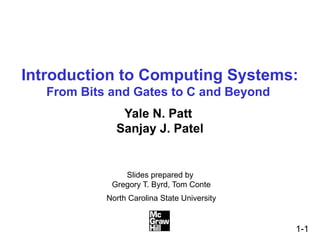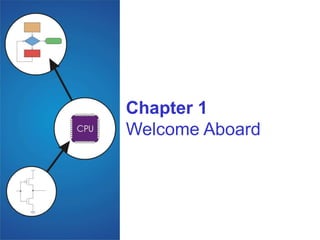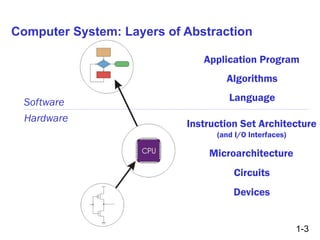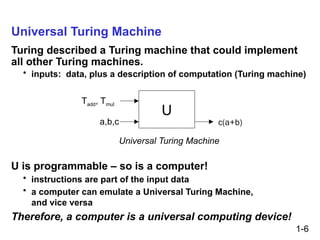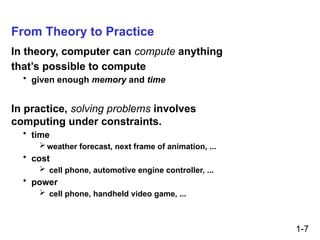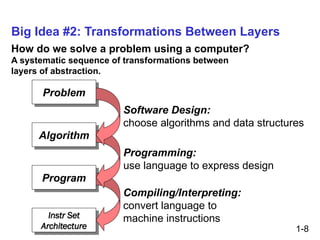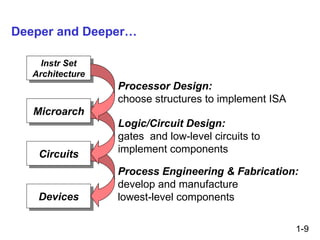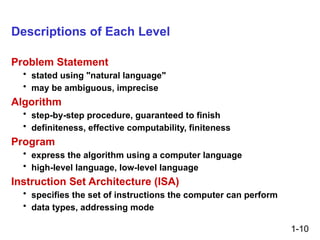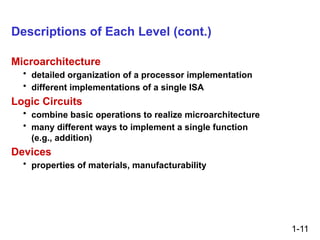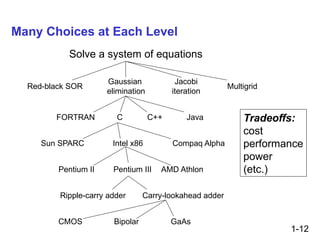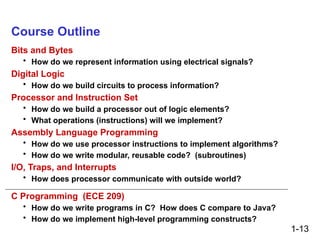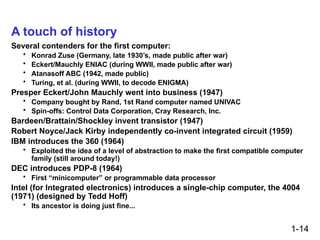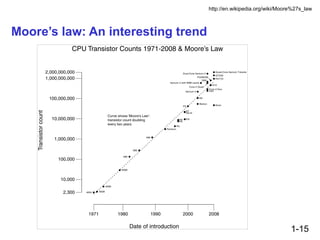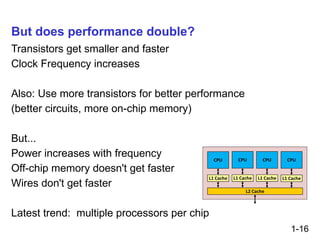ComputerProgrammingCPattPatelChapter.pptx
- 1. 1-1 Introduction to Computing Systems: From Bits and Gates to C and Beyond Yale N. Patt Sanjay J. Patel šÝšÝßĢs prepared by Gregory T. Byrd, Tom Conte North Carolina State University
- 3. 1-3 Computer System: Layers of Abstraction Software Hardware Application Program Language Instruction Set Architecture (and I/O Interfaces) Microarchitecture Circuits Devices Algorithms
- 4. 1-4 Big Idea #1: Universal Computing Device All computers, given enough time and memory, are capable of computing exactly the same things. = = PDA Workstation Supercomputer
- 5. 1-5 Turing Machine Mathematical model of a device that can perform any computation â Alan Turing (1937) âĒ ability to read/write symbols on an infinite âtapeâ âĒ state transitions, based on current state and symbol Every computation can be performed by some Turing machine. (Turingâs thesis) Tadd a,b a+b Turing machine that adds Tmul a,b ab Turing machine that multiplies For more info about Turing machines, see http://cgi.student.nada.kth.se/cgi-bin/d95-aeh/get/umeng
- 6. 1-6 Universal Turing Machine Turing described a Turing machine that could implement all other Turing machines. âĒ inputs: data, plus a description of computation (Turing machine) U a,b,c c(a+b) Universal Turing Machine Tadd, Tmul U is programmable â so is a computer! âĒ instructions are part of the input data âĒ a computer can emulate a Universal Turing Machine, and vice versa Therefore, a computer is a universal computing device!
- 7. 1-7 From Theory to Practice In theory, computer can compute anything thatâs possible to compute âĒ given enough memory and time In practice, solving problems involves computing under constraints. âĒ time ï weather forecast, next frame of animation, ... âĒ cost ï cell phone, automotive engine controller, ... âĒ power ï cell phone, handheld video game, ...
- 8. 1-8 Big Idea #2: Transformations Between Layers How do we solve a problem using a computer? A systematic sequence of transformations between layers of abstraction. Problem Algorithm Program Software Design: choose algorithms and data structures Programming: use language to express design Instr Set Architecture Compiling/Interpreting: convert language to machine instructions
- 9. 1-9 Deeper and DeeperâĶ Instr Set Architecture Microarch Circuits Processor Design: choose structures to implement ISA Logic/Circuit Design: gates and low-level circuits to implement components Devices Process Engineering & Fabrication: develop and manufacture lowest-level components
- 10. 1-10 Descriptions of Each Level Problem Statement âĒ stated using "natural language" âĒ may be ambiguous, imprecise Algorithm âĒ step-by-step procedure, guaranteed to finish âĒ definiteness, effective computability, finiteness Program âĒ express the algorithm using a computer language âĒ high-level language, low-level language Instruction Set Architecture (ISA) âĒ specifies the set of instructions the computer can perform âĒ data types, addressing mode
- 11. 1-11 Descriptions of Each Level (cont.) Microarchitecture âĒ detailed organization of a processor implementation âĒ different implementations of a single ISA Logic Circuits âĒ combine basic operations to realize microarchitecture âĒ many different ways to implement a single function (e.g., addition) Devices âĒ properties of materials, manufacturability
- 12. 1-12 Many Choices at Each Level Solve a system of equations Gaussian elimination Jacobi iteration Red-black SOR Multigrid FORTRAN C C++ Java Intel x86 Sun SPARC Compaq Alpha Pentium II Pentium III AMD Athlon Ripple-carry adder Carry-lookahead adder CMOS Bipolar GaAs Tradeoffs: cost performance power (etc.)
- 13. 1-13 Course Outline Bits and Bytes âĒ How do we represent information using electrical signals? Digital Logic âĒ How do we build circuits to process information? Processor and Instruction Set âĒ How do we build a processor out of logic elements? âĒ What operations (instructions) will we implement? Assembly Language Programming âĒ How do we use processor instructions to implement algorithms? âĒ How do we write modular, reusable code? (subroutines) I/O, Traps, and Interrupts âĒ How does processor communicate with outside world? C Programming (ECE 209) âĒ How do we write programs in C? How does C compare to Java? âĒ How do we implement high-level programming constructs?
- 14. 1-14 A touch of history Several contenders for the first computer: âĒ Konrad Zuse (Germany, late 1930âs, made public after war) âĒ Eckert/Mauchly ENIAC (during WWII, made public after war) âĒ Atanasoff ABC (1942, made public) âĒ Turing, et al. (during WWII, to decode ENIGMA) Presper Eckert/John Mauchly went into business (1947) âĒ Company bought by Rand, 1st Rand computer named UNIVAC âĒ Spin-offs: Control Data Corporation, Cray Research, Inc. Bardeen/Brattain/Shockley invent transistor (1947) Robert Noyce/Jack Kirby independently co-invent integrated circuit (1959) IBM introduces the 360 (1964) âĒ Exploited the idea of a level of abstraction to make the first compatible computer family (still around today!) DEC introduces PDP-8 (1964) âĒ First âminicomputerâ or programmable data processor Intel (for Integrated electronics) introduces a single-chip computer, the 4004 (1971) (designed by Tedd Hoff) âĒ Its ancestor is doing just fine...
- 15. 1-15 Mooreâs law: An interesting trend http://en.wikipedia.org/wiki/Moore%27s_law
- 16. But does performance double? Transistors get smaller and faster Clock Frequency increases Also: Use more transistors for better performance (better circuits, more on-chip memory) But... Power increases with frequency Off-chip memory doesn't get faster Wires don't get faster Latest trend: multiple processors per chip 1-16
Editor's Notes
- #12: Sun and Java are trademarks of Sun Microsystems, Inc. SPARC is a trademark of SPARC International, Inc. Intel and Pentium are trademarks of Intel Corporation. Compaq and Alpha are trademarks or service marks of Compaq Computer Corporation. AMD and Athlon and trademarks of Advanced Micro Devices, Inc.
